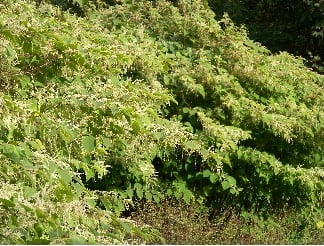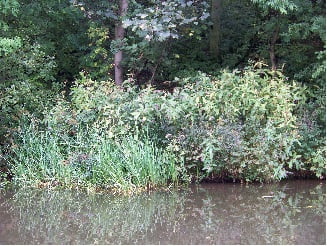History of Japanese Knotweed
The significance of Japanese knotweed (scientific name Fallopia japonica), and the potential problems it can bring, has been the subject of increased publicity in recent years as accounts of it pushing its way through tarmac and concrete and growing at excessive rates have been reported.
Originally brought to Britain from Japan as an ornamental garden plant in the mid-nineteenth century it has, over time, become widespread just about everywhere throughout the country; particularly in urban areas and on roadsides, riverbanks and derelict land. Due to the devastating effect it has on other species as it outcompetes and displaces native flora, it was included on schedule 9 of the Wildlife and Countryside Act in 1981 as a pest species illegal to grow or cause to spread in the wild. It was then classed as controlled waste under the Environmental Protection Act 1990 necessitating its disposal at specially licensed facilities.
What does Japanese knotweed look like?
As Japanese knotweed is a perennial plant, its appearance changes with the seasons. In the early spring, shoots appear with reddish purple leaves. As the plant grows (up to 10cm a day!) the stem elongates and develops purple specks, similar to that of bamboo, and the leaves unfurl and turn green. They have a flattened base and a pointed tip (shovel shaped) and are arranged on the stems in a zig-zag pattern (that is, at a different level from the leaf above or below).
By early summer, the plant is fully grown and reaches up to 2 – 3 metres in height. By late summer (September/October), it produces clusters of creamy white flowers.
During the winter, the leaves fall and the stems turn an orange/brown colour. Stem and leaf material decompose slowly, covering the ground with dense plant litter. During March/April, the plant sends up new shoots which thrive on the stored nutrients and grow rapidly, repeating the seasonal cycle.
Representation
Towards the end of 2011, the Property Care Association (PCA) was approached by the Royal Institute of Chartered Surveyors (RICS) as an organisation deemed to have the competence and expertise to develop industry standards and provide trade association services for the invasive weed control industry. Thus, in March of this year, a new sector of membership was launched to represent contractors and specialists who control damaging invasive plants including Japanese Knotweed.

As with all other sectors of the PCA, companies are heavily vetted before being admitted into membership to ensure they are fully qualified and competent. Consumers can therefore be assured that by using a PCA member, they will be using contractors who have the expertise in removing and disposing of Japanese knotweed effectively using the most efficient methods.
Until the inception of this sector, there was no other accrediting body representing contractors in the control of Japanese knotweed and other invasive weeds. Those looking for a specialist were therefore often faced with differing opinions and proposals on methods of treatments; from the promise of miracle cures after one treatment session to years and years of costly treatments. Using a PCA member will ensure fully qualified contractors who, following auditing and a review of company procedures, are considered to have satisfied a set of standards and criteria in the control of invasive weeds.
Why is Japanese knotweed so problematic?
Despite the horror stories relating to Japanese knotweed and the possible damage it can cause, in truth it is just one of many plants that can pose problems to buildings and other structures. Other perennial plants (including many native British species) can cause similar or worse damage to buildings and underground services and structures.
Japanese knotweed has gained a reputation as a triffid-like species with super plant capabilities, able to push its way through buildings and infrastructures. This was picked up by many lenders back in the early 1990s some of whom consequently refused mortgages on properties blighted by the plant.
In reality, the main cause of damage to buildings is from its creeping rhizomes (underground stems) finding their way into underground services and structures with shallow foundations. In the relatively few examples of Japanese knotweed causing major structural damage to homes or commercial buildings, poor construction or negligence has often been a major contributory factor in the structural failure. In fact, Japanese knotweed is no more damaging than any other plant that has a vigorous, fast growing and extensive perennial root system. Trees and other plants can cause damage to buildings and services as their fine roots penetrate small cracks which then expand as the roots grown. Smaller, faster growing plants like Buddleia can cause significant damage to pavements and areas of hard standing and climbing plants like ivy will smother walls and buildings, eventually weakening or damaging point work, cladding and renders.
However, although the structural damage cause by Japanese knotweed may be no more significant than other plants or trees, it isn’t without its problems.
Additional problems of Japanese knotweed
As well as the most documented and publicised problem of Japanese knotweed causing structural damage, it has a number of other considerations which have contributed to its reputation as an invasive pest weed:
Negative impact on biodiversity and ecosystems
Although Japanese Knotweed generally grows in harmony in its indigenous environment in Japan, North China, Korea and Taiwan, we know it has not readily fitted in with Britain’s native species.
Japanese knotweed has an unfair advantage over native plant species as it has no natural biological enemies outside of Asia to prevent its spread. It invades natural habitats and out-competes the native plants and animals that normally live there, thereby limiting plant and animal species diversity.
The canopy of growth created by an established stand of Japanese knotweed shades out other plants thereby creating areas devoid of diversity. Furthermore, the leaf litter created as the plant dies back at the end of the year provides less beneficial nutrients to the ground and watercourses than the native vegetation it displaces. This can alter food chains in watercourses and the wider environment.
Rapid regeneration
Japanese knotweed spreads incredibly easily. It rarely produces viable seeds (those produced are generally not true Japanese knotweed seeds but hybrids which seldom survive), but is spread by its rhizome fragments (roots) and cut stems. This mainly occurs through fly tipping of contaminated garden waste containing its cut stem or rhizomes or through transporting soil from infested sites during construction work. It can grow in virtually any habitat and is very difficult to control once it is established. Similarly, in river catchments, fragments of rhizomes or cut stems are often washed into watercourses which can then form new plants downstream.

Exacerbated flooding
The ability of the plant to grow in large stands along watercourses can exacerbate flooding by obstructing the free flow of water. This can increase the risk of banks being breached during flood conditions.
What should you do if you find Japanese knotweed?
If Japanese knotweed is found, it is the responsibility of the landowner to control the plant although they don’t have to remove it. However, it is worth remembering that causing the plants to spread by removing or disposing of them incorrectly is illegal so it is imperative that it is dealt with by a specialist who can ensure effective removal of the species.
Control of Japanese knotweed
It has been estimated by DEFRA that the cost of controlling Japanese knotweed across the UK would be in the region of £1.5 billion.
It is not an easy plant to control as the extensive underground rhizome system sustains the plant even when top growth is removed. Therefore treatment often needs to be repeated for long-term control to be achieved.
Methods of control
Chemical control
Chemical control is the most effective treatment for controlling Japanese knotweed in small stands and most domestic situations, as it kills the extensive rhizome system.
Currently, the most commonly used herbicides are Glyphosate based and, for optimum effect, they should be used in late summer. To ensure treatments are effective repeated inspection and treatments is recommended over the space of several years for complete control of the plant.
Ensure a qualified person is used to undertake such treatments. All contractors should hold a National Proficiency Test Council (NPTC) certification (namely PA1 and PA6). Using a PCA approved specialist will ensure this level of qualification and expertise.
Non – Chemical Control
Cutting, mowing or pulling are alternative methods to using chemicals though are not recommended as they risk spreading the plant and are not effective at removing large and long established infestations. For Japanese knotweed control in green or brown field building development sites, excavation, sieving, burial and root barriers treatments in conjunction with monitoring and chemical treatments may be appropriate. These works require high levels and skill and care and must only be undertaken by skilled and competent specialist contractors.
Any cutting methods that produce fragments should be avoided as just a small part of the stem can produce a new plant.

Disposal
All Japanese knotweed waste (including the stems, leaves, rhizomes and crown) must be disposed of correctly to prevent the spread of the plant and meet with legislative requirements.